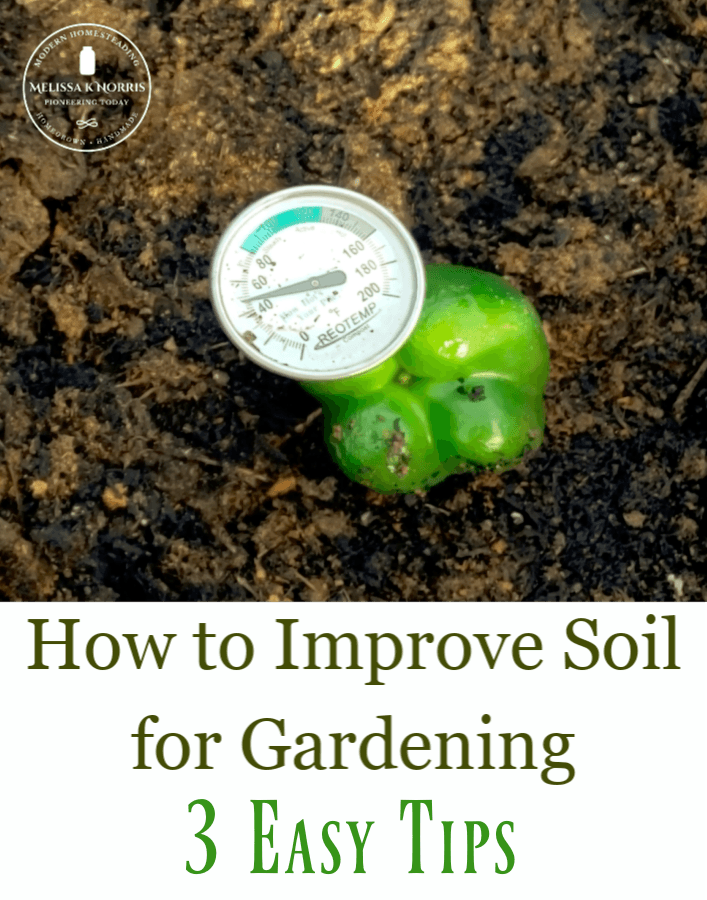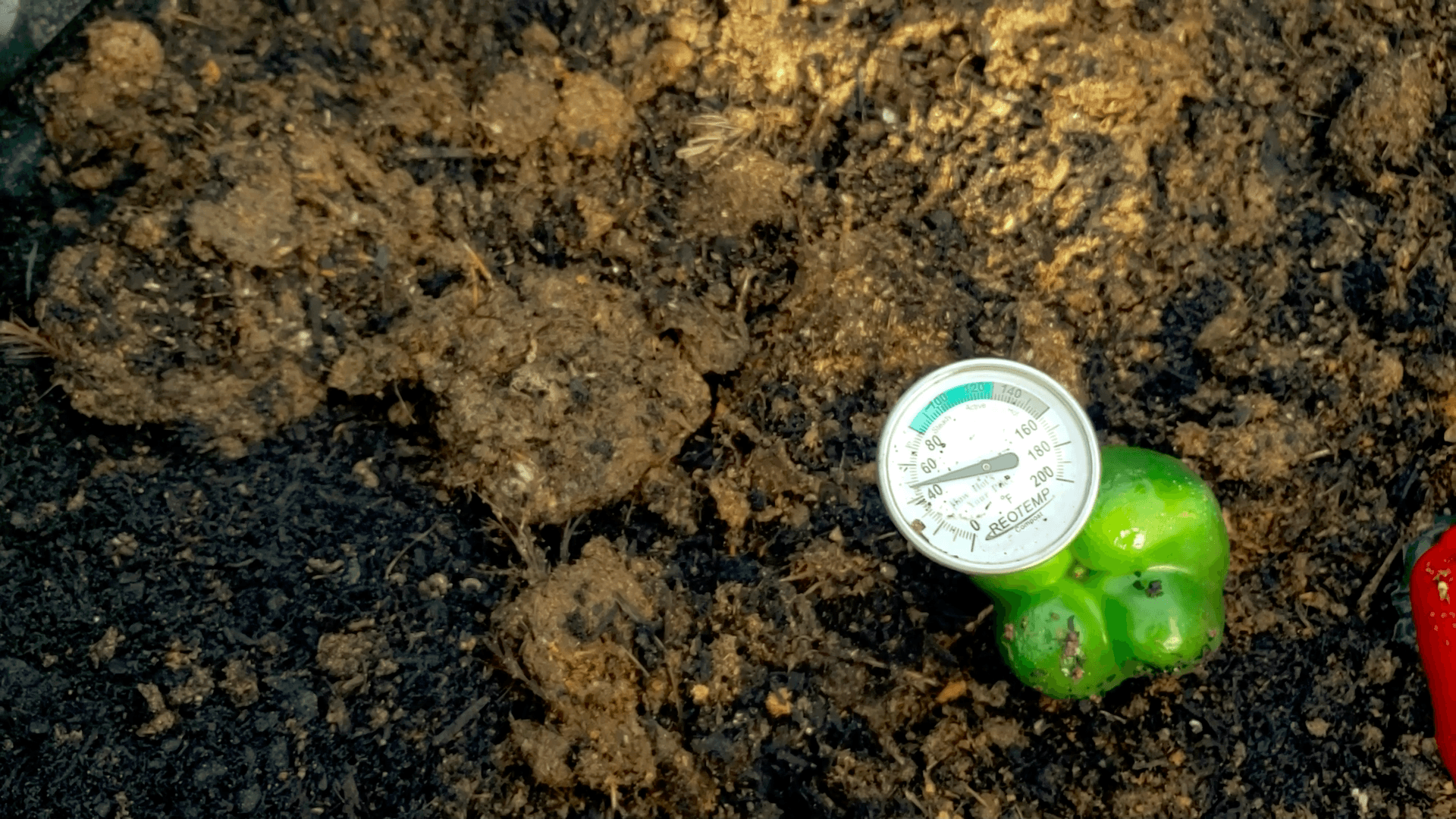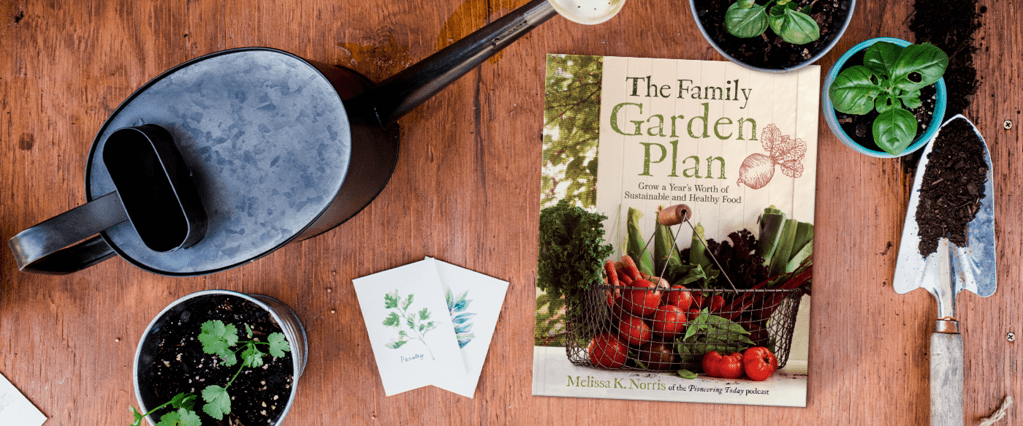How to improve soil for gardening with these 3 easy tips. If you have poor soil you know how frustrating it is to try and grow a garden, but good news, there is help for your soil if it’s less than ideal.
The #1 most asked question from readers on the waitlist for the Pioneering Today Academy was how to improve poor soil naturally and organically. (You definitely want to get on the waitlist if you’re not already by clicking here)

Listen in below to the full podcast, Episode #237 How to Improve Soil for Gardening – 3 Easy Tips of the Pioneering Today Podcast, where we don’t just inspire you, but give you the clear steps to create the homegrown garden, pantry, kitchen, and life you want for your family and homestead.
These tips will work well to improve any soil for gardening but especially with these conditions:
- hard compacted soil
- andy soil
- clay soil
- poor-performing soil
Table of Contents[Hide][Show]
- How to Improve Soil for Gardening – 3 Easy Tips
- 1. Root Crop
- 2. Cover Crop
- 3. Sheet Mulching
- Bonus: Raised Beds
- For more organic gardening tips, check out the following posts:
- Grow more in your garden this year with my new book The Family Garden Plan: Grow a Year’s Worth of Sustainable and Healthy Food
How to Improve Soil for Gardening – 3 Easy Tips
Even if you have pretty good soil, these are practices that you are going to want to put into place.
We can always improve on the health of our soil, which therefore means we are improving the strength and vigor and the amount of harvest that we get from the food planted in said soil.
Building up your soil works if you have regular in-ground gardening. This means that you have gardens in the ground, and you’re going out and planting right into the ground. This method also works for raised bed gardening and container gardening. So most aspects of gardening are applicable no matter how you’re using them, and those three ways are typically the ways people are raising their food. On our homestead, especially, we incorporate all three of these methods.
How to improve soil quality naturally :
1. Root Crop
Root crops help improve clay soil by breaking it up. I like to use radishes because they are going to come to size and be large enough to break up the soil when growing conditions are ideal for radishes in 21 days. Now, if you’re trying to grow carrots or other root crops, it takes them a lot longer for the root to be large enough to break up that soil and begin to aerate.
That’s why I use radishes and because radish seeds are cheap, whereas carrot seeds are harder to germinate. They take longer, especially in compact soil, to be able to put a root down and get big enough in diameter to make a difference. You can also plant radishes year-round, which gives you a more significant opportunity then you do with other root crops. A radish will germinate in soil temperatures of fifty degrees Fahrenheit sometimes even down into the forties, which are a lot cooler than your other crops that require sixty-five-degrees Fahrenheit for soil.
2. Cover Crop
You have the roots going on with the cover crop. The roots are good and using the same philosophy. The roots are not as large as on a cover crop as a radish will be as that root develops. Getting those roots in there can be a really good thing on the cover crop and the other benefit to a cover crop.
If you are picking a hairy vetch that is in the pea or bean family can help fix nitrogen into the soil. If you have depleted soil, nitrogen is often one of the things lacking that helps promote good growth on our vegetables or fruits that we are planting. Another beautiful thing about the cover crop is you have your roots in the ground. Then on top, you have the greens. After the cover crop has been established, ideally, you can take a lawnmower and cut off just at the soil line the top of the green parts after it’s been established, not only when it sprouts because you want to let it grow for a while. But leave the roots in the ground. These roots are going to help breakdown and create organic matter that would even the soil and help keep it from being so compact.
If you do the cover crop, it’s better to cut it off the top with a lawnmower, chop, and drop stythe, or sharp ho so the green matter on top of the soil. As you do compost, it will compost down and become part of your green nitrogen material for your composting.
3. Sheet Mulching
Want to know how to enrich poor soil? Sheet mulching is the answer, with deep layers. You are going to want to have them deeper where they have more of that organic matter because you’re trying to build up a bigger layer of healthy soil, and you’ll get that by doing a really deep layer of composting and manure. If you don’t want to do the sheet mulching, you can do just a lot of compost and have a large pile and bring outside compost if you can find an excellent source to bring in.
The key is those thick layers are that are going to breakdown to create really good organic matter and soil. It will work in with that base layer, and over the years, you’re adding this compost material, and it’s going to create good soil long term. If you start it now and keep up on it because you can do at least two things of compost if not three a year and get it composted down depending on what you have material-wise and your climate. Two years from now, you’re going to have a significant improvement on that soil, and you’ll be able to start growing on that soil.
Bonus: Raised Beds
If you have poor draining, hard, compact soil, a lot of times, people bring in raised beds because the soil isn’t really conducive to growing very good crops and by bringing in a raised bed, especially if it is waterlogged. The drainage is poor, and there is a lot of standing water, or maybe you are on a slope.
People like to do raised beds in those instances because the plants aren’t going to drown, and they’re building up, but they have to bring in soil. If you do a raised bed or a container garden in most cases, you’re doing it because you don’t have the space for container beds.
You don’t have soil to pull from or with raised beds often times the soil itself isn’t very healthy, and it’s faster to bring in a raised bed and to bring in good soil to put in the raised bed than it is to get existing in-ground soil out of a place where it’s healthy. It’s a longer ongoing process. People will even do a set amount of raised beds so that they can start growing their own food, and then they spend time over the seasons for it to make a big difference, and then you can use your in-ground soil with a hybrid model. If you have the funds and you have hard, compact soil and/or sandy soil, soil that is really not ideal, you can bring topsoil and compost by dump truck loads.
When you’re dealing with compact clay soil, one of the things you want to do is to be able to break that soil up before you begin to amend it, so the things you start to put on it to create better soil.
These techniques can work on raised beds, containers, and even though I have well-draining soil because I have been practicing crop rotation in the garden as well. I have been using the methods for decades now, almost 14 years. It’s something I continue to do with these practices every single year.
Resources from Episode #237
Episode #233 Easy Crop Rotation in the Garden Based on Plant Families
Episode #217 Sheet Mulching: the Easy Way to Build Soil & Compost in Layers
Want my best resources and step-by-step instructions to growing your own food, preserving and cooking it, then get on the waitlist for the Pioneering Today Academy here for special sneak peeks and resources normally ONLY reserved for members.
For more organic gardening tips, check out the following posts:
- 10 Things Most Organic Gardeners Forget About
- 13 Basic Steps to Starting a Vegetable Garden
- How to Create a Gardening Plan for More Harvest and Less Stress
- 8 Common Mistakes Made by New Gardeners
- Science-Based Companion Planting Strategies for a Healthier Garden
- Using Vegetable Grow Bags in the Garden
- 5 Tips for Organic Pest Control for Vegetable Gardens
- Hot Climate Gardening Tips
- Cabbage Moth and Slug Control with Organic Gardening Methods
- How to Get Rid of Bugs on Plants Naturally Tips that Actually Work
Grow more in your garden this year with my new book The Family Garden Plan: Grow a Year’s Worth of Sustainable and Healthy Food
Order the Family Garden Plan: Raise a Year’s Worth of Sustainable and Healthy Food and all the bonuses to grow your food here . You’ll learn cold frames and season extenders, composting, and so much more!




